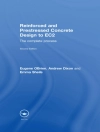This book presents the select proceedings of the 2nd International Conference on Structural Health Monitoring & Engineering Structures (SHM&ES 2021) held at the University of Transport and Communications, Hanoi, Vietnam, during 13–14 December 2021. It covers the recent advances in the fields related to structural health monitoring, damage detection and assessment, non-destructive testing, inverse problems, optimization, artificial neural networks, and evaluation. This book will be useful for researchers and professionals working in the field of health monitoring of engineering structures.
قائمة المحتويات
Weight Optimization of Truss Structures with Different Constraints Using Rao Algorithms and Their Variants.- Crack Identification in Pipe using GA-ANN.- Evaluating the Remaining Flexural Capacity of a CFRP Composite Beam Having Cracked Cross-Section – A Comparison with ACI 440. 2R (2017) for a Case Study.- Reliability Analysis of a System of CFRP Structures on the Piled Raft Foundation Subjected to Earthquakes.- Research on crack extension resistance and remaining strength of high strength concrete using nano-silica.- Reliability Assessment of Low-rise Roof Structures under Wind Loads in the Southern Region of Vietnam.- Evaluate the Safe Working Capacity of the Driven Pile Deviated the Designed Position: a Case Study in Vietnam.- Notch depth identification in CFRP composite beams based on modal analysis using Artificial Neural Network.- RESEARCH AND APPLICATION OF INDIRECT MONITORING METHODS FOR TRANSPORT INFRASTRUCTURE TO MONITOR AND EVALUATE STRUCTURAL HEALTH.- Characteristics of Sea Surface Temperature Fro ts along Vietnamese Coast.- An Eaton Lens Design to Reduce of Earthquake Impact.
عن المؤلف
Dr. R. Venkata Rao is currently working as Professor (Higher Administrative Grade) in the Department of Mechanical Engineering, S.V. National Institute of Technology (SVNIT), Surat, India. He has more than 30 years of teaching and research experience, having completed his B.Tech. in 1988, M.Tech. in 1991, Ph.D. in 2002, and D.Sc. in 2017. His research interests include advanced optimization algorithms and their applications to design, thermal and manufacturing engineering. He has more than 350 research papers to his credit, published in national and international journals and conference proceedings, and has received national and international awards for his research efforts. He is on the editorial boards of several international journals. Apart from conducting a number of short-term training programs for faculty members and professionals on advanced engineering optimization techniques, he has handled numerous research projects including the bi-lateral projects with Austria, Russia, and Slovenia. He has authored six books, and all these have been published by Springer.
Dr. Le Thanh Cuong is Head of Department of Strength of Material and Engineering Structures at the Faculty of Civil Engineering, Ho Chi Minh City Open University, Vietnam. He received his Ph.D. from Ghent University of Belgium. His research focuses on optimization and structural health monitoring, computational science and engineering, structural stability, dynamic analysis, plates and shells. He published papers in computer methods in applied mechanics and engineering, scientific reports, composite structures, and thin-walled structures.
Dr. Samir Khatir is currently Doctor Researcher at Ghent University Belgium Soete laboratory and Adjunct Doctor Assistant at Ho Chi Minh Open University Vietnam. He received Ph.D. in Civil engineering from Ghent University and another Ph.D. in Mechanical engineering from UMBB Algeria. He improved and created many techniques for damage identification, created and improved a new optimisation technique. He has authored and co-authored of over 100 ISI peer-reviewed articles. His primary research interest is in the areas of civil and mechanical engineering such as FEM, XFEM, Iso-geometric analysis (IGA), extended Iso-geometric analysis (XIGA), dynamic, static, damage identification, fracture mechanics, optimization, inverse problem, wear, friction, laminated composites, delamination, and transmissibility.












